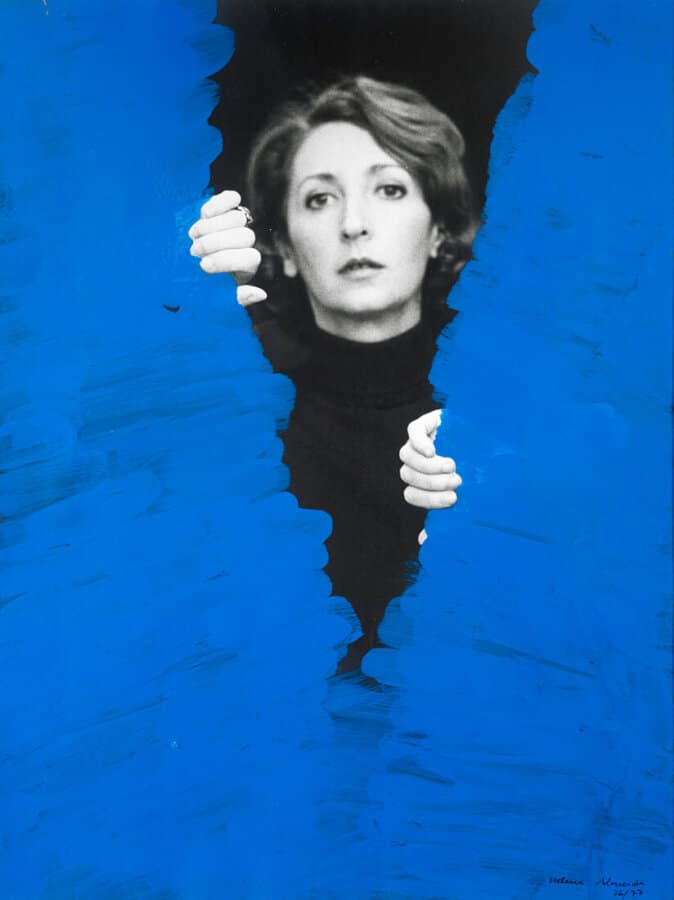
Coll. Fernando d’Almeida
Helena Almeida. My Work is My Body, My Body is My Work
Wiels, Bruxelles
From 10 September to 11 December 2016
Extramural
Watch the video portrait:
Born in 1934 in Lisbon, where she still lives and works today, Helena Almeida studied painting at the Fine Arts Department of the University of Lisbon. From the beginning of her career, she has explored and questioned traditional forms of expression, particularly painting, in an attempt to transgress the space demarcated by the pictorial plane.
Although little-known in France, Helena Almeida is considered to be one of the greatest contemporary Portuguese artists. Her long career has allowed her to gain a reputation from the 1970s onward as one of the leading figures of performance and conceptual art, notably for her participation in large international events such as the Venice Biennales of 1982 and 2005.
The exhibition ” My Work is My Body, My Body is My Work” presents an ensemble of works—painting, photography, video and drawing—produced by the artist from the 1960s to the present day. In these works, the body registers, occupies and defines the space and plays a central role. The exhibition has a retrospective dimension, spanning the different phases of the artist’s career, from her earliest pieces dating from the mid-1960s up until her more recent work.
Following her early three-dimensional works, the artist found in photography a means of overcoming the exteriority of painting, and of allowing “being” and “doing” to coexist in the same medium, “as if I were continuing to affirm: my painting is my body, my work is my body”. Beyond the poetic and metaphorical readings that this work can inspire, it can be seen as an attempt at attaining the limits of a medium, whether photography, performance or sculpture.
The body in Almeida’s work becomes both a sculptural form and a space, object and subject, signifier and signified. The artist’s work is a summary, an act that has been carefully staged, and one that is highly poetic. The representations of these actions also show the context in which Almeida positioned herself. Facing the camera, she refuses that her pictures become self-portraits. She represents primarily her body, but it is a universal body.
Dressed in black, Helena Almeida incorporates elements from her studio into her pictures. She takes position in poses that she has carefully choreographed, in order to create complex compositions, which are often organized in series. In 1969, for the first time, Helena Almeida was photographed by her husband, the architect Artur Rosa. The latter would become permanently associated with her work, as the author or photographer of his wife’s performances, a highly mediatized form of self-representation, which would become a characteristic of her work.
Unlike other contemporary artists who use the self-portrait and self-representation to stage characters through elaborate sets and poses —Cindy Sherman, for example— here the starting point is always the artist’s body. Through photography, Helena Almeida creates a strong relationship between representation (the act of painting or drawing) and presentation (of her own body as a “medium” of that act). “The real physical body of the artist is constantly lost, defaced or obscured behind streaks of paint which sometimes extend it, sometimes cover it, enter or exit (towards or away from) the interior of this body.”
Intus, the work presented by Helena Almeida at the Venice Biennale—she represented Portugal in 2005—is an example of her more recent work. It can be characterized by the relationship between the artist’s body and space (no longer with drawing or painting), and makes use of photography (recurrent in works composed of series) in order to retrace a performance of the artist within the private space of her studio. Nevertheless, the same question continues to underlie Helena Almeida’s work: how can the body and the movement of the body (always that of the artist) succeed in creating a work of art? The intransigence with which Helena Almeida explores this subject makes her œuvre, according to Isabel Carlos, “one of the most radically consistent of Portuguese art from the second half of the twentieth century”.
Curators: João Ribas and Marta Almeida, Fundação de Serralves – Museu de Arte Contemporânea, Porto.
An exhibition organized by Museu de Arte Contemporânea de Serralves, Porto, in collaboration with Jeu de Paume and WIELS, Centre d’art contemporain, Bruxelles.
To buy the catalogue: www.librairiejeudepaume.org
WIELS, Centre d’Art Contemporain
Av. Van Volxem 354
1190 Bruxelles
